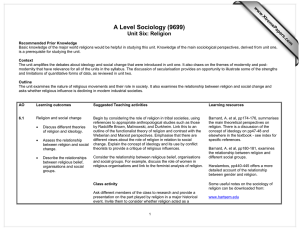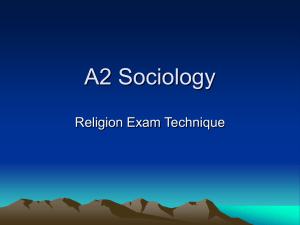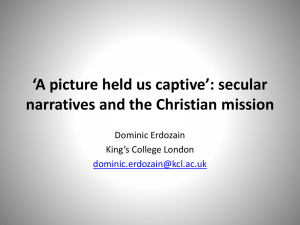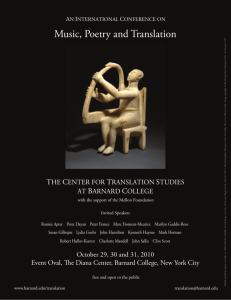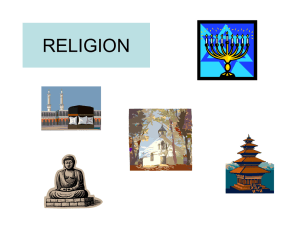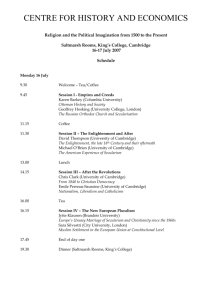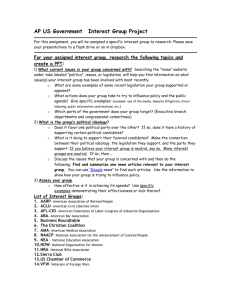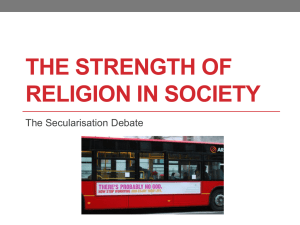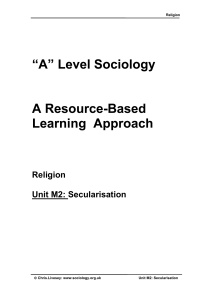www.studyguide.pk A Level Sociology (9699) Unit Six: Religion
advertisement
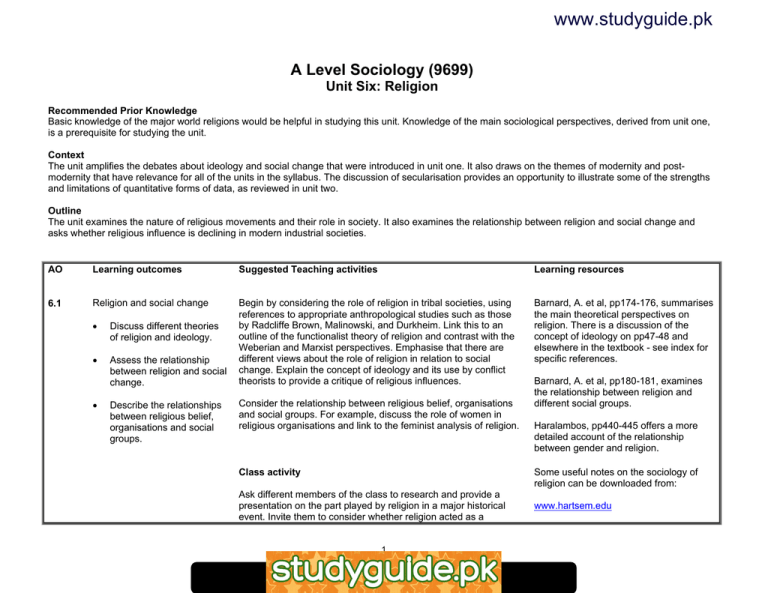
www.studyguide.pk A Level Sociology (9699) Unit Six: Religion Recommended Prior Knowledge Basic knowledge of the major world religions would be helpful in studying this unit. Knowledge of the main sociological perspectives, derived from unit one, is a prerequisite for studying the unit. Context The unit amplifies the debates about ideology and social change that were introduced in unit one. It also draws on the themes of modernity and postmodernity that have relevance for all of the units in the syllabus. The discussion of secularisation provides an opportunity to illustrate some of the strengths and limitations of quantitative forms of data, as reviewed in unit two. Outline The unit examines the nature of religious movements and their role in society. It also examines the relationship between religion and social change and asks whether religious influence is declining in modern industrial societies. AO Learning outcomes Suggested Teaching activities Learning resources 6.1 Religion and social change Begin by considering the role of religion in tribal societies, using references to appropriate anthropological studies such as those by Radcliffe Brown, Malinowski, and Durkheim. Link this to an outline of the functionalist theory of religion and contrast with the Weberian and Marxist perspectives. Emphasise that there are different views about the role of religion in relation to social change. Explain the concept of ideology and its use by conflict theorists to provide a critique of religious influences. Barnard, A. et al, pp174-176, summarises the main theoretical perspectives on religion. There is a discussion of the concept of ideology on pp47-48 and elsewhere in the textbook - see index for specific references. • Discuss different theories of religion and ideology. • Assess the relationship between religion and social change. • Describe the relationships between religious belief, organisations and social groups. Consider the relationship between religious belief, organisations and social groups. For example, discuss the role of women in religious organisations and link to the feminist analysis of religion. Barnard, A. et al, pp180-181, examines the relationship between religion and different social groups. Haralambos, pp440-445 offers a more detailed account of the relationship between gender and religion. Some useful notes on the sociology of religion can be downloaded from: Class activity Ask different members of the class to research and provide a presentation on the part played by religion in a major historical event. Invite them to consider whether religion acted as a 1 www.xtremepapers.net www.hartsem.edu www.studyguide.pk AO 6.2 Learning outcomes Religious movements • Distinguish between cults, sects, denominations and churches. • Assess the secularisation thesis. • Discuss the relationships between religious fundamentalism, modernity and post-modernity. Suggested Teaching activities Learning resources conservative force or a dynamic for change in the example under review. Link the presentations to a summary of the main sociological perspectives on religion and its relationship to social change. For detailed information about Weber's theory of religion, see: www.ne.jp/asahi/moriyuki/abukuma Begin by defining the different forms of religious organisations, including churches, denominations, sects and cults. Discuss the reasons for the growth of sects and new religious movements. Move on to the secularisation debate, reviewing the evidence for and against the idea that religious influence is declining in modern industrial societies. Point out the difficulty of defining religion and the problems involved in measuring religious belief and commitment. Consider examples of religious revivalism, such as new wave Christianity in the USA and western Europe. Barnard, A. et al, pp177-180, distinguishes between church, denomination and sect. The arguments for and against the secularisation thesis are examined on pp181-186 Use examples to illustrate the meaning of religious fundamentalism and consider the reasons for the apparent resurgence in this form of religious practice in both Christianity and Islam. Link to the discussion about the transition from modernity to post-modernity and the processes of globalisation in particular. Haralambos, pp495-501, provides an excellent summary of recent contributions to the Sociology of Religion from a postmodernist perspective. Class activity Invite the class to design a simple survey that could be used for assessing the extent of religiosity in their society. Discuss the potential problems in designing the survey and formulating appropriate questions. Link to an assessment of the strengths and limitations of the empirical data used by sociologists on both sides of the secularisation debate. Barnard, A. et al, pp186-187 discusses religious fundamentalism and its links with post-modernity. The Classic Collection video, Eileen Barker on The Making of a Moonie, provides an excellent case study for discussing cults and their relationship to established religious organisations. An excellent source for information about different religious movements is: http://religiousmovements.lib.virginia.edu/ 2 www.xtremepapers.net
